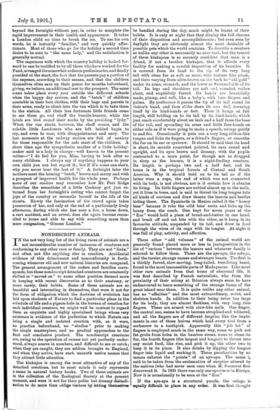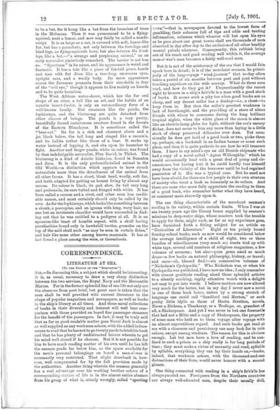NONDESCRIPT ANIMALS.
IN the not very long list of the living races of animals are a not inconsiderable number of instances of creatures not conforming to any other race or family. They are not " links," and often not like anything else in creation. Accidental evidence of this detachment and nonconformity is forth- coming whenever old and new natural histories are compared. The general arrangement of the orders and families corre- sponds, but these nondescript detached creatures are constantly shifted or " moved on" to some other position deemed more in keeping with recent discoveries as to their anatomy, or more rarely, their habits. Some of these animals are so beautiful and interesting in themselves, that were it not for the form of obligation which the doctrine of evolution has laid upon students of Nature to find a particular place in the schedule of life and a pigeon-hole in the bureau of creation for each individual creature, we might well be content to regard them as exquisite and highly specialised beings whose very existence is evidence of the perfection to which Nature can bring a single and isolated creation with, as it were, no practice beforehand, no " studies " prior to making the single masterpiece, and no gradual approaches to the final and conclusive product. The nondescript creatures are, owing to the operation of causes not yet perfectly under- stood, always scarce in numbers, and difficult to see or catch; when they are caught, they are seldom brought to England, and when they arrive, have such uncouth native names that they attract little attention.
The kinkajou is among the most attractive of any of the detached creations, but to most minds it only represents a name in natural history books. Two of these animals are in the collection of the Zoological Society at the present moment, and were it not for their polite but dreamy disincli- nation to do more than oblige visitors by letting themselves
be handled during the day, much might be learnt of their habits. It is only at night that they display the full charms of their disposition and accomplishments ; but even seen by daylight they are obviously almost the most desirable of possible pets which the world contains. To describe a creature so unlike any other is necessarily no easy task, but the tamest of these kinkajous is so serenely confident that man is a friend, if not a brother kinkajou, that it affords every facility for making a careful inspection of its beauties. It is covered from its head to the tip of its very long tail with close fur as soft as moss, with texture like plush, and tints varying from olive-brown on the back to "old gold" under its arms, stomach, and the lower or flattened side of its taiL Its legs and shoulders are soft ant rounded, rather short, and exquisitely furred. Its hands are beautifully made, plump, and soft, like a baby's, with bare fingers and palms. By preference it passes the tip of its tail round its visitor's hand, and then slides down its own tail, lowering itself by its hind-hands or feet. Then it hangs at full length, still holding on to its tail by its hind-hands, which just reach comfortably about an inch and a half from the base of the tail, and spreading its arms and little fore-hands on either side as if it were going to make a speech, swings gently to and fro. Occasionally it puts out a very long ribbon-like tongue and licks its fingers, or a friend's fingers, or smooths the fur on its ear or eyebrow. It should be said that its head is short, its muzzle somewhat pointed, its ears round and upright, and its eyes brown and dreamy, with the pupils contracted to a mere point, for though not so drugged in sleep as the lemurs, it is a night-feeding creature. Its length is perhaps two and a half feet, and its home is in the tropical forests of Central and South America. Why it should hold on to its tail as if the latter were a rope, the end of which was not connected with its body, is not obvious, nor is it certain how it obtains its living. Its little fingers are webbed almost up to the nails, yet it lives in trees, and is said to thrust its long tongue into all kinds of crevices and draw thence the insects and beetles hiding there. The Spaniards in Mexico called it the " honey bear" because it robs the wild bees' nests and licks up the honey from the comb. One kept for seven years at the " Zoo " would hold a piece of bread-and-butter in one band, and break off and eat bits with the other, as it hung in its favourite attitude, suspended by its tail, and drew in food through the wires of its cage with its tongue. At night it was full of play, activity, and affection.
Three other " odd volumes " of the animal world are generally found placed more or less in juxtaposition in the list of "various " between the lemurs and whatever family is selected to follow them. These are the aye-aye, the colugo, and the tarsier, strange names and stranger beasts. The first is a thickly furred, slow-moving, long-tailed, tree-living beast, found in the most inaccessible parts of Madagascar. Like most other rare animals from that home of abnormal life, it was first described by French naturalists, who from the proximity of their colony at Reunion always seem to have endeavoured to learn something of the strange fauna of the great island near them. It is quite unlike any other animal, has no "affinities" and the most extraordinary, weird, and skeleton hands. In addition to their being twice too large for its body, they are almost fleshless, with very long, thin fingers. These are armed with claw-like nails. One finger, the central one, seems to have become atrophied and withered, and all the fingers are of different lengths, like the imple- ments in one of those knives which hold every tool from a corkscrew to a toothpick. Apparently this " job lot " of fingers is employed much in the same way, some to pick out fat grubs from holes in the bamboo stems, some to clean its fur, the fourth fingers (the largest and longest) to thrust into any moist food, like rice, and pick it up, the other two to keep it in its place. It also drinks by dipping the longest finger into liquid and sucking it. These peculiarities by no means exhaust the "points" of an aye-aye. The name is said to be taken from the exclamation of surprise uttered by the natives (who had never seen one) when M. Sonnerat first discovered it. In 1831 there was only one specimen in Europe. Now it is occasionally to be seen at the " Zoo."
If the aye-aye is a structural puzzle, the colugo is equally difficult to place in any order. It was first thought
to be a bat, for it hung like a bat from the branches of trees in the Moluccas. Then it was pronounced to be a flying- squirrel, next a lemur, and now may fairly be called a nonde- script. It is as large as a cat, is covered with soft, lemur-like fur, but has a parachute, not only between the fore-legs and
hind-legs, as flying-squirrels have, but also between the hind- legs, like a bat,—" a strange and perplexing animal," as an early naturalist plaintively remarked. The tarsier is not less so. " Spectrum " is its name, and its appearance is weird and
fantastic. It has a tale like a piece of fox-tail grass, hands and toes with fiat discs like a tree-frog, enormous eyes, upright ears, and a woolly body. Its mere appearance scares the Javanese peasants from their rice-fields in fear of the "evil eye." though it appears to live mainly on lizards and to be quite harmless.
The West African water-shrew, which has the fur and shape of an otter, a tail like an eel, and the habits of an aquatic insect-feeder, is only an extraordinary form of a well-known family. But creatures like the panda, the lophiornys, and the binturong are quite detached from other classes of beings. The panda is a very pretty, beautifully furred carnivorous creature found in the forests of the Eastern Himalayas. It is sometimes called the "bear-cat." Its fur is a rich red chestnut above and a jet black below, the tail long and ringed like a racoon's, and its habits rather like those of a bear. It sucks up water instead of lapping it, and sits upon its haunches to fight. Another and larger panda, white in colour, was found by that indefatigable naturalist, Pere David, in Thibet. The binturong is a kind of Asiatic, kinkajou, found in Sumatra and Java. It is the only prehensile-tailed animal in the Old World,—a distinction which appears to have struck naturalists more than the detachment of the animal from all other forms. It has a short, blunt head, woolly, soft fur, and teeth adapted for getting an honest living by almost any means. Its colour is black, its gait slow, its tail very long and prehensile, its ears tufted and fringed with white. It has been called a racoon and a civet, and other even less credit- able names, and most certainly should only be called by its own. As for the lophiornys, which looks like something between a skunk, a porcupine, and an iguana with long, wavy hair, no
one but an inveterate classifier would have succeeded in find- ing out that he was entitled to a pedigree at all. It is an opossum-like beast of humble aspect, with a skull having peculiarities found only in hawksbill turtles, granules on the top of the said skull such "as may be seen in certain fishes," and hair like none other among known mammals. It has at last found a place among the mice, or thereabouts.



















































 Previous page
Previous page